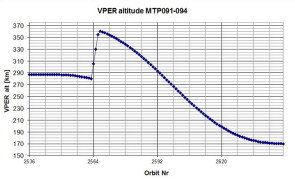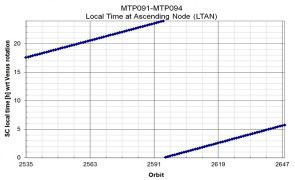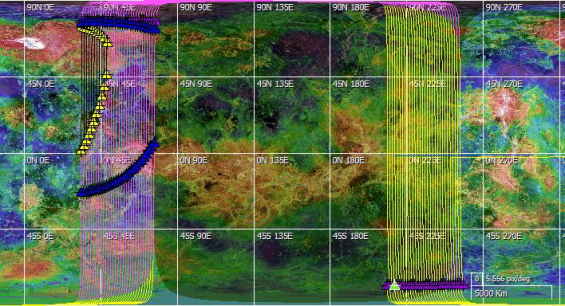No. 262 - Continuation of Earth occultation season, end of solar eclipse season, start of Atmospheric Drag Experiment campaign, and special operations due to extensive ground station maintenance
Cebreros ground station
All Cebreros ground station activities were nominal during this reporting period. Part of this and the previous reporting period coincided with scheduled extensive annual maintenance on the ground station, from 17 June to 1 July. The Cebreros ground station was unavailable during this time, and Venus Express routine operations were performed temporarily with ESA's ground stations in Malargüe, Argentina, and New Norcia, Australia.
Malargüe ground station
During these annually scheduled maintenance periods at Cebreros, disruptive maintenance is performed and the ground station cannot be used for uplink or downlink. To accommodate daily uplinks and downlinks during the unavailability of Cebreros until 1 July, ESA's ground station in Malargüe, Argentina, was used to communicate with the spacecraft. As Mars Express was also scheduled to use the station each day, it shared station time with Venus Express. The communications windows in this planning period were shifted from the descending branch of the Venus Express orbit (during which the Cebreros ground station normally communicates with the spacecraft), to the ascending branch, when the spacecraft was in direct contact with the Malargüe ground station. The ascending branch of the Venus Express orbit is also the preferred period in which to obtain science data, so the modified communication windows resulted in reduced time available for some of science operations.
The Venus Express and Mars Express flight control teams arranged to use the Malargüe antenna by alternating long and short passes between the two missions from 17 to 30 June. Under this arrangement, on one day Mars Express would be scheduled for a long pass of about 6.5 hours, and Venus Express would be scheduled for about 2.75 hours. Then on the next day, Mars Express would be scheduled for a short pass of about 2.25 hours, and Venus Express would be scheduled for a longer pass of about 7 hours. The short passes do not allow much data dumping, but they allow time for command uplinks and telemetry downlinks to ensure safe operations. The short passes for Venus Express took place on 23, 25, 27 and 30 June. The long passes occurred on 22, 24, 26, 28 and 29 June.
New Norcia ground station
During this time, the ESA ground station in New Norcia was not booked for use on three days for a brief period when it had direct visibility of Venus Express. The spacecraft was already using this ground station for radio science observations; in those orbits where other missions were not immediately using the station after Venus Express, the operations team requested an extension of their use of the ground station to include data downlinks in the available time. This is unusual, and has only been done once before. The request was analysed and agreed to by the flight control team and the ground station scheduling office. On 23 June, 25 June and 27 June, Venus Express downlinked data via the New Norcia ground station.
High accuracy spacecraft ranging
ESA's Cebreros and New Norcia ground stations were used for a Delta Differential One-way Ranging (delta-DOR, or DDOR) measurement at the start of the Cebreros communications pass on 7 July.
These high accuracy ranging measurements are carried out with the Venus Express spacecraft on a regular basis to support the accurate determination of the ephemeris for the planet Venus that is maintained by NASA's Solar System Dynamics Group.
For more information about DDOR, see "Delta-DOR measurements".
End of the twenty-fourth eclipse season
Venus Express's twenty-fourth eclipse season ended during this planning period. The last eclipse occurred on 2 July 2013. The next eclipse season starts on 31 August 2013.
Particular science observations are carried out during eclipse seasons: for further details, see the Scientific Focus section below and 'Science observations with Venus Express during an eclipse'.
Battery charge reconfiguration and deep discharge test
The mission's twenty-fourth eclipse season ended on 2 July. The battery's end-of-charge (EOC) state, which had been at 100% for the eclipse season, was subsequently lowered to 80% on 8 July.
During solar eclipse seasons, the spacecraft is in complete darkness during a portion of each orbit when Venus blocks out the Sun. At this time, the spacecraft bus and payload are powered by the on-board battery, which must then be recharged again to 100% prior to the next eclipse. The battery (composed of three individual battery packs) is sized so that at the end of its life, the spacecraft can go through the longest eclipse and still retain enough stored power for the spacecraft to successfully complete a transition to 'safe mode' in the event of a spacecraft system anomaly.
Outside eclipse seasons, sufficient battery power must be maintained at all times for a transition to safe mode. However, a lower (than 100%) battery energy level (or end-of-charge state) can be maintained, as no provision is needed for eclipses. Lowering the battery's end-of-charge state prolongs its life.
In addition to the change in battery charge state, a battery deep discharge test was performed 8 July. This is a standard test that is repeated at intervals to determine the health of the battery. The battery is discharged very deeply, and its voltage is compared to the predicted values. The model describing the battery discharge is updated if necessary. In this case, the battery health was nominal.
Continuation of the fifteenth Earth occultation season
The fifteenth Earth occultation season continued during this entire planning period; occultation observations were performed in every other orbit. The spacecraft radio signal is received on Earth via the New Norcia antenna in western Australia, designated DSA-1. New Norcia is specifically used for the radio science because it has the best viewing angle to Venus Express orbit when the spacecraft is at pericentre (the Venus Express orbit is 24 hours long).
During this reporting period, Venus Radio science experiment (VeRa) occultation observations were alternated so that the Spectroscopy for Investigation of Characteristics of the Atmosphere of Venus (SPICAV) instrument could obtain measurements of the Nitrogen Oxide concentrations in the atmosphere during eclipses.
For more information, please see the Scientific Focus section (below) and 'Venus Express Earth occultation seasons'.
Twelfth Atmospheric Drag Experiment campaign
The twelfth Atmospheric Drag Experiment campaign began during this reporting period. Six drag passes were performed in this planning period, between 15 and 20 July; the campaign continued into the next reporting period.
Calibration passes (also known as pre-ADE passes) were carried out over a twenty-day period prior to the first pass on 15 July. Data from the pre-ADE measurements were calculated and stored on-board, then downlinked along with the spacecraft telemetry.
The ADE passes were performed at pericentre altitudes as low as 170 km. These ADE passes used radio tracking from ESA's New Norcia Ground station.
For more information on ADE campaigns, see the link in the right-hand menu.
Orbit control manoeuvres
Two orbit correction manoeuvres were carried out during this reporting period. The first was performed at pericentre on 30 June, to adjust the orbit period. The second manoeuvre was performed at apocentre on 1 July, for a very small adjustment to the pericentre altitude.
At this stage of the mission, with low fuel levels on the spacecraft, the orbit correction manoeuvres are carried out as a number of small burns – rather than fewer large burns – to ensure that they are performed accurately. An explanation for this can be found in Status Report no. 257.
Summary of main activities
The table below shows a chronology of the main spacecraft bus activities in the reporting period:
| Main activities during reporting period | |||
| ADE = Atmospheric Drag Experiment; AOS = Acquisition of Signal; CEB = Cebreros; DOR = Differential One-way Ranging; DOY = Day of year; EOC = End of Charge; MET = Mission elapsed time; MLG = Malargüe; NNO = New Norcia; OCM = Orbit Correction Manoeuvre | |||
|
MET (Day) |
Date | DOY | Main Activity |
| 2784 | 23-Jun-2013 | 174 | NNO occultation pass; NNO communication pass; MLG communication pass; CEB shutdown for planned annual maintenance. |
| 2785 | 24-Jun-2013 | 175 | MLG communication pass; CEB shutdown for planned annual maintenance. |
| 2786 | 25-Jun-2013 | 176 | NNO occultation pass; NNO communication pass; MLG communication pass; CEB shutdown for planned annual maintenance. |
| 2787 | 26-Jun-2013 | 177 | Telemetry bitrate changed to 91kbps before AOS; MLG communication pass; pre-ADE calibration pass; CEB shutdown for planned annual maintenance. |
| 2788 | 27-Jun-2013 | 178 | NNO occultation pass; NNO communication pass; MLG communication pass; CEB shutdown for planned annual maintenance. |
| 2789 | 28-Jun-2013 | 179 | MLG communication pass; CEB shutdown for planned annual maintenance. |
| 2790 | 29-Jun-2013 | 180 | MLG communication pass; pre-ADE calibration pass; CEB shutdown for planned annual maintenance. |
| 2791 | 30-Jun-2013 | 181 | MLG communication pass; CEB under planned annual maintenance shutdown; OCM at pericentre. |
| 2792 | 01-Jul-2013 | 182 | NNO occultation pass; CEB communications passes resume after annual maintenance shutdown; OCM at apocentre. |
| 2793 | 02-Jul-2013 | 183 | CEB communication pass; end of the twenty-fourth eclipse season. |
| 2794 | 03-Jul-2013 | 184 | NNO occultation pass; CEB communication pass. |
| 2795 | 04-Jul-2013 | 185 | Pre-ADE calibration pass; CEB communication pass; CEB monthly maintenance. |
| 2796 | 05-Jul-2013 | 186 | NNO occultation pass; CEB communication pass; CEB monthly maintenance. |
| 2797 | 06-Jul-2013 | 187 | CEB communication pass. |
| 2798 | 07-Jul-2013 | 188 | NNO occultation pass; CEB communication pass; Delta-DOR with NNO and CEB. |
| 2799 | 08-Jul-2013 | 189 | Pre-ADE calibration pass; CEB communication pass; Battery deep discharge test; Battery EOC state lowered to 80%. |
| 2800 | 09-Jul-2013 | 190 | NNO occultation pass; CEB communication pass. |
| 2801 | 10-Jul-2013 | 191 | CEB communication pass. |
| 2802 | 11-Jul-2013 | 192 | NNO occultation pass; CEB communication pass. |
| 2803 | 12-Jul-2013 | 193 | Pre-ADE calibration pass; CEB communication pass. |
| 2804 | 13-Jul-2013 | 194 | NNO occultation pass; CEB communication pass. |
| 2805 | 14-Jul-2013 | 195 | CEB communication pass. |
| 2806 | 15-Jul-2013 | 196 | CEB communication pass; first pass of the twelfth ADE campaign. |
| 2807 | 16-Jul-2013 | 197 | CEB communication pass; ADE pass. |
| 2808 | 17-Jul-2013 | 198 | CEB communication pass; ADE pass. |
| 2809 | 18-Jul-2013 | 199 | CEB communication pass; ADE pass. |
| 2810 | 19-Jul-2013 | 200 | CEB communication pass; ADE pass. |
| 2811 | 20-Jul-2013 | 201 | CEB communication pass; ADE pass. |
At the end of the reporting period on 20 July, Venus Express was 209 million kilometres from Earth. The one-way signal travel time was 699 seconds. The final oxidizer mass was 18.149 kg and the final fuel mass was 11.099 kg.
Scientific focus
This reporting period falls under the 94th medium term plan (MTP), which covered the period from 23 June to 20 July 2013. The fifteenth Earth occultation season continued in this MTP, while the twenty-fourth solar eclipse season ended on 2 July.
The twelfth ADE campaign had high priority during this 28-day period. The ADE passes started on 15 July and continued through this planning period, ending only on 27 July. Calibration passes (also known as pre-ADE passes) were carried out over a twenty-day period prior to the first pass on 15 July. Data from the pre-ADE measurements were calculated and stored on-board, then downlinked along with the spacecraft telemetry.
For short periods of time during Earth occultation seasons, the spacecraft's radio signal can pass through Venus' atmosphere before it is received on Earth. These periods are exploited for unique radio science measurements of Venus' atmosphere using the Venus Radio science experiment (VeRa).
While the spacecraft is in the shadow of the planet during solar eclipses, the Venus Monitoring Camera (VMC) can make use of an infrared 'window' in the clouds to obtain low resolution images of the surface.
The Spectroscopy for Investigation of Characteristics of the Atmosphere of Venus (SPICAV) Nitrogen Oxide mapping campaign continued to be a priority in this reporting period. VeRa occultation observations were alternated with SPICAV measurements of the Nitrogen Oxide concentrations in the atmosphere during eclipses; the latter were carried out in half of the orbits. VMC cloud tracking observations were prioritised at the end of the eclipse season to improve the global coverage at particular latitudes.
Payload activities
All instruments performed nominally during this reporting period.
| ASPERA | The instrument was regularly operated nominally as part of the routine plan. |
| MAG | The instrument was regularly operated nominally as part of the routine plan. |
| PFS | The instrument was not operated. |
| SPICAV | The instrument was regularly operated nominally as part of the routine plan. |
| VMC | The instrument was regularly operated nominally as part of the routine plan. |
| VeRa | The instrument was regularly operated nominally as part of the routine plan. |
| VIRTIS | The instrument was regularly operated nominally as part of the routine plan. |
Future milestones
- End of the fifteenth Earth occultation season
- Start of in-bound quadrature operations
Legal disclaimer
This report is based on four ESOC mission operations reports, MOR #395 through MOR #398, as well as the MTP94 Master Science Plan. Please see the copyright section in the Terms and Conditions for this site.






